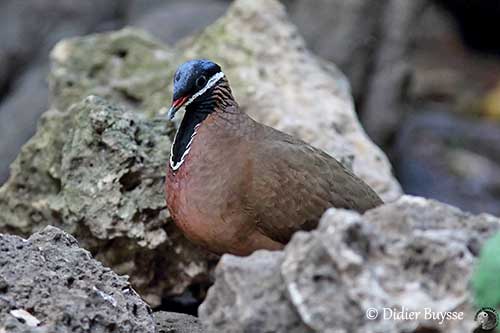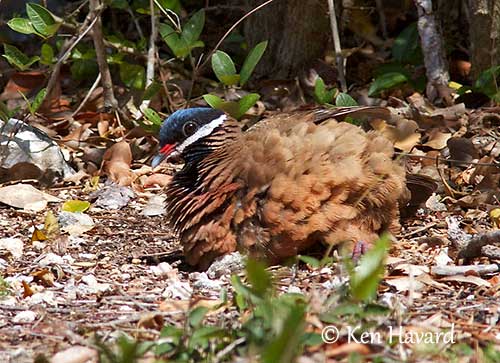
Fr: Colombe à tête bleue
Ang: Blue-headed Quail-Dove
All: Kubataube
Esp: Paloma perdiz cubana
Ita: Tortora quaglia testazzurra
Nd: Blauwkopkwartelduif
Sd: Blåhuvad vaktelduva
Photographers:
Didier Buysse
Vision d’Oiseaux
Ken Havard
My Bird Gallery & Flickr gallery 1 & Flickr gallery 2
Text by Nicole Bouglouan
Sources:
HANDBOOK OF THE BIRDS OF THE WORLD vol 4 by Josep del Hoyo-Andrew Elliott-Jordi Sargatal - Lynx Edicions - ISBN: 8487334229
PIGEONS AND DOVES by David Gibbs, Eustace Barnes and John Cox - Pica Press Sussex - ISBN: 1873403607
BIRDS OF THE WEST INDIES – by Herbert Raffaele, Kristin Williams et Tracy Pedersen – Helm – ISBN: 9780713649055
Neotropical Birds – Cornell Lab of Ornithology
Blue-headed Quail-Dove
Starnoenas cyanocephala
Columbiformes Order – Columbidae Family
INTRODUCTION:
The Blue-headed Quail-Dove is a monotypic species endemic to Cuba, and the largest of the Cuban doves. This resident dove is mainly terrestrial, often seen walking on the ground through its forest habitat, foraging for invertebrates and fruits.
The Blue-headed Quail-Dove is a rare bird. Its decline is the result of both hunting pressure and habitat loss. It is classified as Endangered.

REPRODUCTION OF THIS SPECIES:
The breeding season takes place from April to July. The nest of the Blue-headed Quail-Dove is a platform made with twigs, sometimes with a lining of rootlets and always with fresh leaves. It is placed in dense low shrub or among tree roots, or atop tree stump, and sometimes in Tillandsia epiphytes. It is usually built less than 1,75 metres from the ground.
The female lays 1-2 white eggs. The incubation lasts about 17 days. The chicks have long, buffy-white down. The fledging period is currently unknown.
PROTECTION / THREATS / STATUS:
The Blue-headed Quail-Dove is a rare bird in Cuba, restricted to humid forest. This species is threatened by excessive hunting, degradation of the habitat through clearance and fragmentation, and introduced predators.
This species is extinct on the Isle of Pines.
The population is estimated at 1,000/2,499 individuals, equivalent to 667/1,666 mature individuals. This population is suspected to be declining.
The Blue-headed Quail-Dove is currently classified as Endangered.
Male and female are similar, but she has reduced gloss in hindneck and breast.
The juvenile is duller, with feathers edged buff-brown on back, scapulars and wings. The breast feathers show some buff fringes too. The head is dull blue. Legs and feet are dull red.
RANGE:
The Blue-headed Quail-Dove is endemic to Cuba where it is resident. It has never established in Jamaica, in spite of repeated introductions. It was also recorded in S Florida in past.
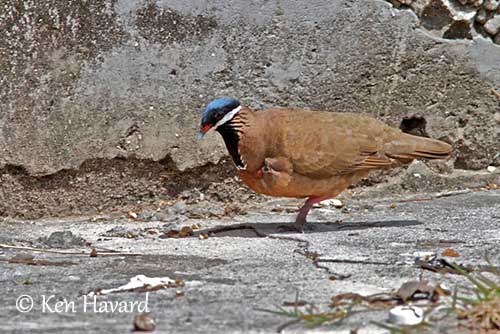
BEHAVIOUR IN THE WILD:
The Blue-headed Quail-Dove feeds mainly on seeds, fruits, berries, snails and small arthropods, grubs and caterpillars. It may feed on crop seeds from cultivated fields.
It feeds by walking on the ground and forages in the thick leaf litter. It may also forage at forest edge and along tracks. It can be seen in pairs, sometimes in groups of 10-15 individuals.
During the breeding season, the male calls for its mate from low perches. This species becomes territorial during this period, and the nest area is strongly defended against intruders.
The courtship displays of this species are poorly known. The male bows in front of the female, bobs its head repeatedly while the tail is raised and the wings spread.
The Blue-headed Quail-Dove is resident in Cuba. It is more often seen walking than flying, but it flies up to a low perch when disturbed or to call. It flies over short distance to escape a predator. It is usually shy and inconspicuous.
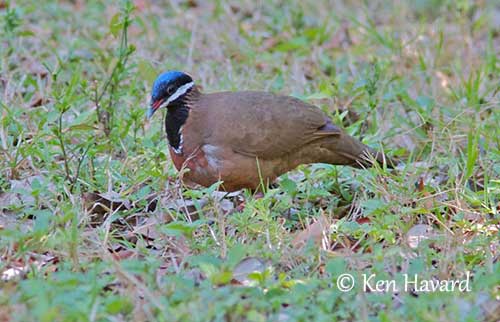
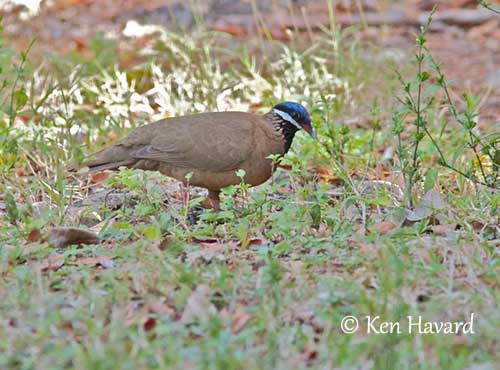
HABITAT:
The Blue-headed Quail-Dove frequents deciduous forest with dense canopy where it can be seen walking in the undergrowth, often close to swampy areas. However, it requires open understory and stony forest floor with thick leaf litter. It can be seen occasionally in highlands, up to 500 metres of elevation or more.
CALLS AND SONGS: SOUNDS BY XENO-CANTO
The Blue-headed Quail-Dove utters series of similar notes “uuuu-up, uuuu-up…” with the last syllable rising and ending abruptly. The male calls from low perch during the breeding season, usually for long periods.
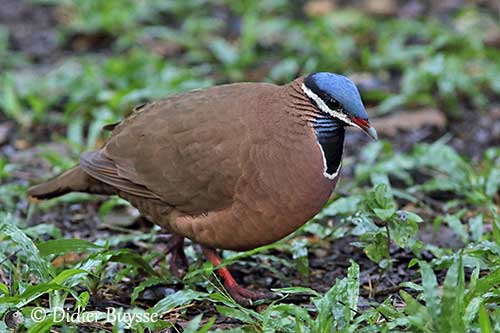
DESCRIPTION OF THE BIRD:
Biometrics:
Length: 29-34 cm
Weight: 213-290 g
The Blue-headed Quail-Dove adult has brownish-cinnamon body plumage, varying from buffy-brown to dark brown. On the upperwing, the primaries are darker. The tail is brown with slate-grey outer rectrices. Hindneck and mantle are tinged purple.
On the underparts, the breast is pinkish-purple, but mostly olive-brown with purple wash on breast sides. The belly is buffy-brown to dark brown.
On the head, forehead and crown and bright cobalt blue, bordered by black eye line extending behind the eye and joining on the nape. There is a conspicuous white stripe below the black eye line. Chin and throat are velvet black, forming a black bib bordered with white. The black malar area and the lower cheek are streaked bright blue.
The bill has red base and pale blue tip. The eyes are dark brown. Legs and feet are reddish, with hexagonal scales on the front.
